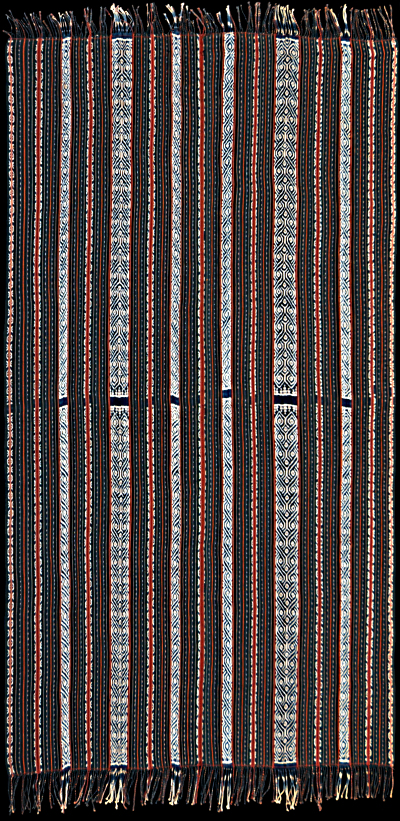| |
086 Timor, West Timor
Beti naek (men's wrap)  
|
| Locale: | Insana |
| Period: | Second quarter of the 20th c. |
| Yarn: | Fine hand-spun cotton in all ikated bands and stripes; commercial cotton in the accent stripes. |
| Technique: | Warp ikat |
| Panels: | 2 |
| Size: | 111 x 206 cm (3' 7" x 6' 9") LW: 1.86 |
| Weight: | 765 g (27.0 oz), 335 g/m2 (1.10 oz/ft2) |
| Design: | The type Yeager and Jacobson categorize as 'multiple design stripe selimut'. The colour palette with indigo dominant and the tight ikating of complex patterns are typical for Insana. The main motif has a distinct directionality, with visual movement flowing outward from the centre towards the extremities. While the two panels are of equal width, the cloth is not symmetric: the widest ikated band on one panel is 66 mm, on the other merely 50 mm; the second widest are 27 mm verses 23 mm. The difference is made up by slightly wider tertiary bands. |
| Comment: | A brilliant piece, lively and well executed, strongly present and intellectually challenging with its convoluted shapes. Clearly made by a weaver with a firm grip on her mind and with firm fingers. The ikat looks as if carved, and is intentionally difficult: nothing in ikat is harder to create than curving lines, and this cloth is all curves, with lines meandering over and under each other. The asymmetry implies that the panels were not made in parallel, a practice which is more common in Ambenu with its Savunese influence than anywhere else on Timor. |
| Background: | Chapters on Timor and West Timor. |
| Exhibited: | Timor: Totems and Tokens, Museu do Oriente, Lisbon, 2019/20. |
| Published: | Timor: Totems and Tokens, 2019.
|
| Sources: | Similar in overall appearance to Insana beti from Kio Pukan in Yeager and Jacobson, Textiles of Western Timor, Plate. 158. The intricate motif recalls that of Insana wood-carving with its knotted motifs shown on Fig. 128s. It is also somewhat similar to the Insana beti of Plate 159 which is decorated with interwoven patterning of the same kind. |
| |

©Peter ten Hoopen, 2025
All rights reserved.
|


